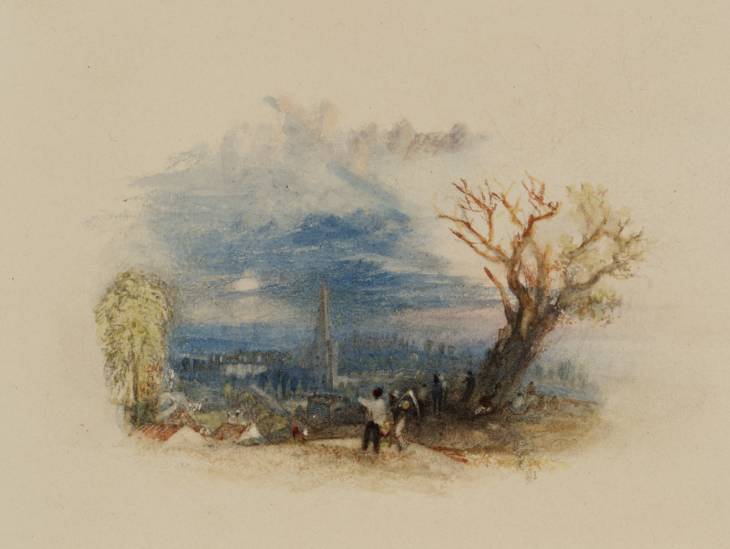Joseph Mallord William Turner A Village. Evening, for Rogers's 'Poems' c.1830-2
Joseph Mallord William Turner,
A Village. Evening, for Rogers's 'Poems'
c.1830-2
Joseph Mallord William Turner 1775–1851
A Village. Evening, for Rogers’s ‘Poems’ circa 1830–2
D27685
Turner Bequest CCLXXX 168
Turner Bequest CCLXXX 168
Gouache and watercolour, approximately 80 x 113 mm on white wove paper, 241 x 306 mm
Stamped in black ‘CCLXXX 168’ bottom right
Stamped in black ‘CCLXXX 168’ bottom right
Accepted by the nation as part of the Turner Bequest 1856
Exhibition history
1904
National Gallery, London, various dates to at least 1904 (226).
1936
Four Screens, British Museum, London, July 1936–February 1937 (no catalogue but numbered 4).
1975
Turner in the British Museum: Drawings and Watercolours, British Museum, London, May 1975–February 1976 (183, reproduced).
2001
William Turner: Licht und Farbe, Museum Folkwang, Essen, September 2001–January 2002, Kunsthaus Zürich, February–May 2002 (130, reproduced in colour).
References
1903
E.T. Cook and Alexander Wedderburn (eds.), Library Edition: The Works of John Ruskin: Volume I: Early Prose Writings 1834–1843, London 1903, pp.233, 244.
1904
E.T. Cook and Alexander Wedderburn (eds.), Library Edition: The Works of John Ruskin: Volume XIII: Turner: The Harbours of England; Catalogues and Notes, London 1904, pp.380–1.
1906
E.T. Cook and Alexander Wedderburn (eds.), Library Edition: The Works of John Ruskin: Volume XXI: The Ruskin Art Collection at Oxford, London 1906, p.214.
1906
E.T. Cook and Alexander Wedderburn (eds.), Library Edition: The Works of John Ruskin: Volume XXII: Lectures on Landscape; Michelangelo; Tintoret, London 1906, p.378.
1909
A.J. Finberg, A Complete Inventory of the Drawings in the Turner Bequest, London 1909, vol.II, p.901, as ‘Twilight’.
1966
Adele Holcomb, ‘J.M.W. Turner’s Illustrations to the Poets’, unpublished Ph.D thesis, University of California, Los Angeles 1966, pp.85, 99, 100, as ‘Village: Twilight’.
1975
Andrew Wilton, Turner in the British Museum: Drawings and Watercolours, exhibition catalogue, British Museum, London 1975, pp.12, 20, 114 no.183, reproduced.
1979
Andrew Wilton, The Life and Work of J.M.W. Turner, Fribourg 1979, p.440 no.1178, reproduced.
1993
Jan Piggott, Turner’s Vignettes, exhibition catalogue, Tate Gallery, London 1993, p.97.
2001
Andrew Wilton, Inge Bodesohn-Vogel and Helena Robinson, William Turner: Licht und Farbe, exhibition catalogue, Museum Folkwang, Essen 2001, pp.55, 196 no.130, reproduced (colour).
A Village. Evening was engraved by Edward Goodall and published as the head-piece to Part I of a long poem entitled ‘The Pleasures of Memory’ in the 1834 edition of Rogers’s Poems.1 Within this section of the poem, the narrator describes ‘the pleasing melancholy’ of revisiting the village where he once lived:2
Twilight’s soft dews steal o’er the village-green,
With magic tints to harmonize the scene.
Stilled is the hum that thro’ the hamlet broke,
When round the ruins of their ancient oak
The peasants flocked to hear the minstrel play,
And games and carols closed the busy day.
Her wheel at rest, the matron thrills no more
With treasured tales, and legendary lore.
All, all are fled; nor mirth nor music flows
To chase the dreams of innocent repose.
All, all are fled; yet still I linger here!
What secret charms this silent spot endear?
(Poems, pp.7–8)
With magic tints to harmonize the scene.
Stilled is the hum that thro’ the hamlet broke,
When round the ruins of their ancient oak
The peasants flocked to hear the minstrel play,
And games and carols closed the busy day.
Her wheel at rest, the matron thrills no more
With treasured tales, and legendary lore.
All, all are fled; nor mirth nor music flows
To chase the dreams of innocent repose.
All, all are fled; yet still I linger here!
What secret charms this silent spot endear?
(Poems, pp.7–8)
Turner’s vignette shows the village from a distance. Two figures stand in the foreground, one of them apparently giving directions to the other. The right-hand side of the composition is occupied by a thickset ‘ancient oak’. The tree, which is half in leaf and half barren, may allude to the passage of time and the ageing process, both themes that are clearly present in Rogers’s text.
One of the most salient features of this design is the brilliant dusky blue colouring of the sky and distant landscape. Perhaps to compensate for the loss of this rich palette, certain elements of the composition are rendered more dramatically in Goodall’s engraving. For example, the contrast between the living and dead portions of the oak tree is more pronounced and the broad rays of a setting sun have been added to what was previously a moonlit evening sky.
Technical notes:
Watermark: ‘J. Whatman | Turkey Mill | 1826’
Watermark: ‘J. Whatman | Turkey Mill | 1826’
Verso:
Inscribed by unknown hands in pencil ‘10’ and ‘34’ top centre left and ‘15 a’ centre and ‘CCLXXX 168’ bottom centre and ‘* D27685’ bottom right
Stamped in black ‘CCLXXX 168’ centre
Stamped in black ‘CCLXXX 168’ centre
Meredith Gamer
August 2006
How to cite
Meredith Gamer, ‘A Village. Evening, for Rogers’s ‘Poems’ c.1830–2 by Joseph Mallord William Turner’, catalogue entry, August 2006, in David Blayney Brown (ed.), J.M.W. Turner: Sketchbooks, Drawings and Watercolours, Tate Research Publication, December 2012, https://www

